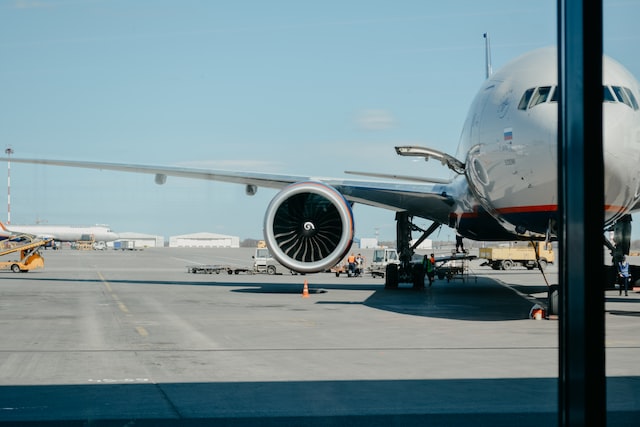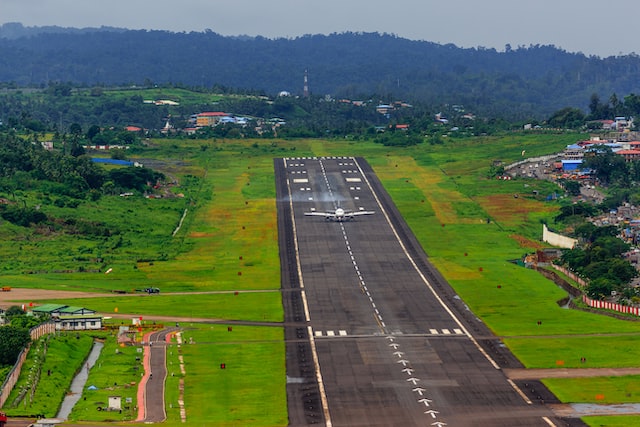An airport is a complex infrastructure that includes facilities for aircraft operations, maintenance, passenger and cargo handling, and support services such as air traffic control, security, and firefighting. An airstrip, on the other hand, is a much simpler facility that typically only includes a runway for takeoffs and landings, with limited facilities for maintenance, fueling, or passenger handling.
What is an Airport?
(Photo by Ivan Shimko on Unsplash )

An airport is a complex infrastructure that serves as a hub for air transportation. It typically includes a runway or runways for aircraft takeoff and landing, as well as various facilities for the operation, maintenance, and support of aircraft.
The facilities at an airport can include terminals for passenger and cargo handling, air traffic control towers, maintenance hangars, fuel storage and dispensing areas, and support services such as firefighting, security, and emergency medical care. The airport may also have ground transportation options such as taxi, shuttle, or rental car services, as well as shops, restaurants, and other amenities for passengers.
In addition, larger airports may also have additional facilities such as cargo warehouses, maintenance and repair facilities for aircraft, and air traffic control systems that monitor and manage air traffic in the surrounding airspace.
Overall, the airport serves as a hub for air transportation, connecting people and goods to destinations around the world and supporting the global economy and trade.
What is an Airstrip?
(Photo by Lenstravelier on Unsplash )

An airstrip is a simple, often rural, runway for aircraft to take off and land. Unlike an airport, an airstrip typically lacks many of the facilities and services that are common at larger airports.
An airstrip typically consists of a runway and a few basic support structures, such as a small terminal building, fuel storage, and possibly a control tower. Airstrips are often used for small aircraft, such as private planes, crop dusters, or medical evacuation flights, and may not have the same level of air traffic control or safety equipment as a full-fledged airport.
In some remote areas, an airstrip may serve as the primary means of transportation, connecting communities to the rest of the world. In other cases, an airstrip may be used by recreational pilots for private flying, or by companies for transporting cargo or personnel to remote locations.
Overall, while an airstrip provides a basic level of aviation services, it is limited in the scope and scale of operations compared to a full airport, and may not have the same level of support and infrastructure.
What is the difference between an airport and an airstrip?
An airport and an airstrip are both facilities designed to support aviation activities, but there are significant differences between the two. An airport is a complex facility that supports a wide range of aviation activities, including passenger and cargo flights, maintenance and repair of aircraft, and ground support services. Airports have extensive facilities and services, including passenger terminals, air traffic control towers, maintenance hangars, fuel storage and dispensing areas, ground transportation options, and support services such as firefighting and emergency medical care. Airports also have extensive air traffic control systems and safety equipment, and are subject to extensive regulation by government agencies.
In contrast, an airstrip is a simple facility that provides only the most basic support services for aviation activities. An airstrip typically consists of a runway and a few basic support structures, such as a small terminal building, fuel storage, and possibly a control tower. Airstrips are often used for smaller aircraft, such as private planes, crop dusters, or medical evacuation flights, and may not have the same level of air traffic control or safety equipment as a full-fledged airport. An airstrip may be located in remote or rural areas and may not be easily accessible by ground transportation.
In summary, while an airport is a complex facility that supports a wide range of aviation activities and provides extensive facilities and services, an airstrip is a simple facility that provides only basic support services for aviation activities.
What are the key differences between an airport and an airstrip?
Purpose
Airports serve as hubs for air transportation, connecting people and goods to destinations around the world, while an airstrip is used for smaller aircraft and may serve remote communities or support private flying or cargo transportation.
Facilities
Airports typically have a wide range of facilities and services, including passenger terminals, air traffic control towers, maintenance hangars, fuel storage and dispensing areas, ground transportation options, and support services such as firefighting and emergency medical care. In contrast, an airstrip has only the most basic facilities, such as a runway, a small terminal building, and fuel storage.
Operations
Airports support a wide range of aviation activities, including passenger and cargo flights, maintenance and repair of aircraft, and ground support services. An airstrip has a more limited range of operations, serving only small aircraft and providing basic support services.
Size
Airports are generally larger than airstrips, both in terms of the size of their runways and the number and scale of their facilities and services. Airports may have multiple runways, while an airstrip may have only one.
Air Traffic Control
Airports have extensive air traffic control systems that monitor and manage air traffic in the surrounding airspace, while an airstrip may not have any air traffic control services.
Safety Equipment
Airports have extensive safety equipment and personnel, such as firefighting and emergency medical services, to respond to incidents and emergencies. An airstrip may have only limited safety equipment and personnel.
Accessibility
Airports are often located near major cities and are easily accessible by road or rail, while an airstrip may be located in remote or rural areas and may not be easily accessible by ground transportation.
Passenger Amenities
Airports generally have a range of passenger amenities, such as shops, restaurants, and lounges, while an airstrip may not have any passenger amenities.
Security
Airports have extensive security measures, including security screenings and baggage checks, while an airstrip may have limited or no security measures.
Commercial Operations
Airports support commercial operations, such as scheduled passenger and cargo flights, while an airstrip may only support private or non-commercial flights.
Maintenance and Repair
Airports have facilities for maintenance and repair of aircraft, while an airstrip may not have such facilities.
Navigational Aids
Airports have advanced navigational aids, such as air traffic control systems and runway lighting, while an airstrip may have limited or no navigational aids.
Regulation
Airports are subject to extensive regulation by government agencies, such as the Federal Aviation Administration (FAA) in the United States, while an airstrip may have fewer regulatory requirements.
Cost
Airports are generally more expensive to build and operate than airstrips, due to the extensive facilities, services, and equipment they require.
What are landside and airside areas in an airport?
Airports are divided into two main areas: landside and airside. The landside area is accessible to the general public and includes facilities such as parking lots, rental car facilities, public transportation options, and passenger terminal buildings. This is where passengers arrive at the airport and go through check-in and security screenings before proceeding to the airside area.
The airside area, on the other hand, is restricted to passengers who have gone through security screenings and have a boarding pass for a flight. This area includes the gates, concourses, waiting areas, and other areas where passengers wait for their flights. Additionally, the airside area includes the aircraft apron, which is the area where planes park and load and unload passengers and cargo. The airside area also includes runways, taxiways, and ramps, which are the areas accessible to aircraft for takeoff and landing.
The landside area of an airport includes parking lots, fuel tank farms, access roads, and passenger terminal buildings, while the airside area includes gates, concourses, waiting areas, aircraft apron, runways, taxiways, and ramps.
What is an airbase?
An airbase is a military facility that is primarily used to support military aviation operations. An airbase typically includes one or more runways, hangars for aircraft maintenance and storage, and support facilities such as housing for military personnel, fuel storage, and air traffic control. In addition to supporting military aviation operations, airbases may also serve as a forward operating base for military personnel and may have additional facilities such as barracks, dining halls, and medical facilities.
An airbase may be used for a wide range of military aviation activities, including combat operations, training, transportation, and logistics. Airbases are typically secured and are not accessible to the general public. They may also have extensive security measures in place, such as perimeter fences, surveillance systems, and guards, to protect against unauthorized access and potential security threats.
Why do airports have 3 letter codes?
Airports have three-letter codes because it makes them easier to identify and helps to standardize airport codes globally. The three-letter codes for airports, also known as IATA (International Air Transport Association) codes, are used by airlines, air traffic control, and other aviation organizations around the world.
The IATA was established in 1945 with the goal of promoting the safe and efficient operation of international air travel. One of the ways it sought to achieve this goal was by standardizing the codes used to identify airports. The three-letter code system was introduced in the 1940s and has since become widely used and recognized as the standard for identifying airports around the world.
The three-letter codes for airports are designed to be unique and memorable, making it easier for people to quickly identify and remember the codes for the airports they use frequently. This helps to ensure efficient communication and coordination between airlines, air traffic control, and other aviation organizations.
In summary, airports have three-letter codes as part of an international standard established by the IATA to promote the safe and efficient operation of international air travel. The three-letter codes make it easier to identify and remember airport codes and help to ensure efficient communication in the aviation industry.
Can you own your own airstrip?
Yes, it is possible for individuals or organizations to own their own airstrip. Private airstrips are often owned by individuals who live near them and use them for personal or recreational purposes, such as flying small aircraft or pilot training. They may also be owned by organizations, such as companies or flying clubs, that operate aircraft for business or recreational purposes.
However, owning an airstrip comes with several responsibilities and requirements. Depending on the location and size of the airstrip, there may be regulations and restrictions imposed by local, state, or federal agencies. For example, there may be requirements for obtaining permits, conducting regular inspections, and ensuring the safety of the airstrip and the aircraft using it.
Additionally, owning an airstrip requires a significant investment in the land and infrastructure, including the runway, taxiways, hangars, and other support facilities. There may also be ongoing maintenance costs, such as for resurfacing the runway and maintaining the infrastructure.
In summary, while it is possible for individuals or organizations to own their own airstrip, it comes with several responsibilities and requirements, and may require a significant investment in the land and infrastructure.
What are the procedure needed to own ones own airstrip?
The procedure for owning an individual airstrip will vary depending on the location and the specific requirements of the local, state, and federal agencies with jurisdiction over the land and airspace. However, the following steps provide a general overview of the process:
- Obtain land ownership: The first step in owning an airstrip is to obtain ownership of the land where the runway will be located. This can be done through a real estate purchase or through a lease arrangement with the landowner.
- Determine zoning requirements: Before starting construction of an airstrip, it is important to determine the zoning requirements for the area. This will ensure that the airstrip is located in an area that is suitable for aviation use and that the construction meets local land-use regulations.
- Obtain permits and approvals: Depending on the location of the airstrip, there may be several permits and approvals required from local, state, or federal agencies. For example, permits may be required for construction, operation, and maintenance of the airstrip.
- Conduct a site assessment: Before construction, it is important to conduct a site assessment to determine the suitability of the site for an airstrip. Factors to consider include the terrain, wind patterns, proximity to other aviation activities, and environmental conditions.
- Develop a safety plan: An airstrip must be designed and operated in a manner that ensures the safety of aircraft and persons operating on the ground. A safety plan should be developed and implemented to ensure that the airstrip meets all safety requirements.
- Build and maintain the infrastructure: Once the necessary approvals and permits have been obtained, construction of the runway, taxiways, and other infrastructure can begin. Regular maintenance of the infrastructure is also important to ensure the safety and reliability of the airstrip.
- Register the airstrip: Once the construction of the airstrip is complete, it is important to register the airstrip with the relevant aviation authorities. This will ensure that the airstrip is recognized and can be used by aircraft.
This process may vary depending on the location, the type of aircraft that will be using the airstrip, and the specific requirements of the local, state, and federal agencies with jurisdiction over the land and airspace. It is important to consult with local aviation authorities and professional advisors to ensure that all necessary steps are taken and that the airstrip meets all applicable regulations and standards.
Featured Image By – pascal-meier-UYiesSO4FiM-unsplash








